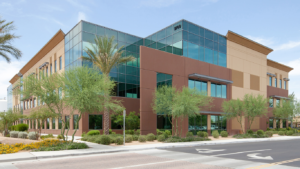As vacancy rates shrink, new industrial and office developments could break ground in the Valley
Plans for a 600,000 SF spec industrial warehouse in Southwest Phoenix and a 92,000 SF, 2-story office building in Chandler’s Price Corridor are signs that those two property types are making a comeback in Metro Phoenix, some industry experts are cautiously predicting.
In January, California-based Doug Allred Company broke ground on Park Place, the Valley’s first post-recession spec office complex to be built since 2009. In October, The Alter Group breaks ground on a 605,700 SF spec warehouse at the Buckeye Logistics Center.
And according to those in the trenches, the reason could be as simple as supply and demand.
“Developers are responding to the lack of (industrial) supply available in the market by revving up activity, particularly in the Southwest Valley,” says Bob Mulhern, managing director for Colliers International. “By the end of this year, multiple developments totaling approximately 4 MSF are forecast to be under way, with other projects likely to enter the development pipeline in 2013.”
With regard to office, the market is still very weak for that property type, says Clay Wells, director of business for McShane Construction Company. However, he does add that news of the new office building in Chandler is encouraging.
“The street buzz is that they may already have a tenant who will take the entire building,” Wells says. That rumor, in fact, became reality in June when software maker Infusionsoft announced it would move its headquarters from Gilbert to Park Place in Chandler.
“The other real activity is in Tempe where the next tower at Hayden Ferry will come out of the ground when there are enough leases signed, and that could be a while,” Wells adds. “Downtown is the last submarket where both RED (Development) and Colliers (International) are making noises about new towers. A clue there could be the tower crane at CityScape is in the air and the hotel opens in two weeks.”
According to Cushman & Wakefield research, strong absorption levels driven by trailing 12-month job growth through March of 43,200 jobs are positively influencing both industrial and office vacancy and rent levels. Industrial vacancy levels crested in 2009 at 15.9% and currently are near 12%.
Industrial has been very hot over the past year, especially for users looking at 500,000 SF to 1 MSF buildings. While there is one building (it’s in the West Valley) remaining that fits that criteria, there are three to five developers talking about doing a “spec building in the 300,000 to 600,000 SF range that could be expanded to more than 1 MSF,” Wells says.
There is optimism from the brokers as well.
“The developers who have land holdings that we meet with are now busy with construction preparation and plans in response to an emerging warehouse demand, coupled with a thinned out inventory,” says Isy Sonabend, senior vice president at NAI Horizon. “When we see the first warehouse walls being tilted, it will be the leading indicator that our economy is recovering.”
Office vacancy levels spiked in 2010 at 25% and are more slowly inching their way down. Except for “one-off ” projects, it will be 3 to 5 years before the office market witnesses new development, says Chris Toci, executive director, Cushman & Wakefield of Arizona.
Uncertainty will cloud most business decisions for small- to medium-sized companies where 70+% of all jobs are created in this country, says Mark Singerman, Regional Director – Arizona for Rockefeller Group Development Corporation. This will restrain demand for office space until after the presidential and congressional elections, he adds.
“Larger companies will continue their efforts to consolidate or down size to become more efficient to reduce operating overhead,” Singerman says. “They will represent the majority of office demand until smaller companies feel that they can project their costs for at least the next 2-3 years.
“Hopefully, after the elections, enough uncertainty will be removed so businesses can plan and make strategic moves to grow their businesses, regardless of who or which political party wins in November. Business can adapt to almost any set of circumstances, except uncertainty. This freezes everything.”
On the industrial side, Singerman says, changes in consumer buying patterns that include more purchases via the Internet will continue to impact retailer’s capital investment plans.
“It makes sense for national retailers to allocate some of their investment capital to warehouse/distribution facilities to service their e-commerce business,” he says. “Th is has been driving a lot of the industrial demand in the Southwest Valley. I believe this will continue with national companies. But as with office space, the small- to medium-size users of industrial space are afraid to make real estate decisions until the future is less uncertain.”
A lot of what happens in the Valley depends on what happens to supply and demand for industrial buildings in the Inland Empire of California, namely Riverside and San Bernardino counties. If the spec buildings being developed in that market do well, which reports from brokers in that market indicate that they will, that will bode well for the Southwest Valley, which has traditionally been a viable yet less expensive alternative for users looking to service southern California, Arizona and other Southwestern states.
If, however, the Inland Empire struggles to find tenants for all of their spec buildings, that is a good indicator that demand is not strong enough to warrant spec inventory in the Southwest Valley.
“For the rest of this year, I see build-to-suit continuing to dominate industrial development activity in the Phoenix area,” Singerman says. “Long term, spec buildings will return as demand firms up.”



